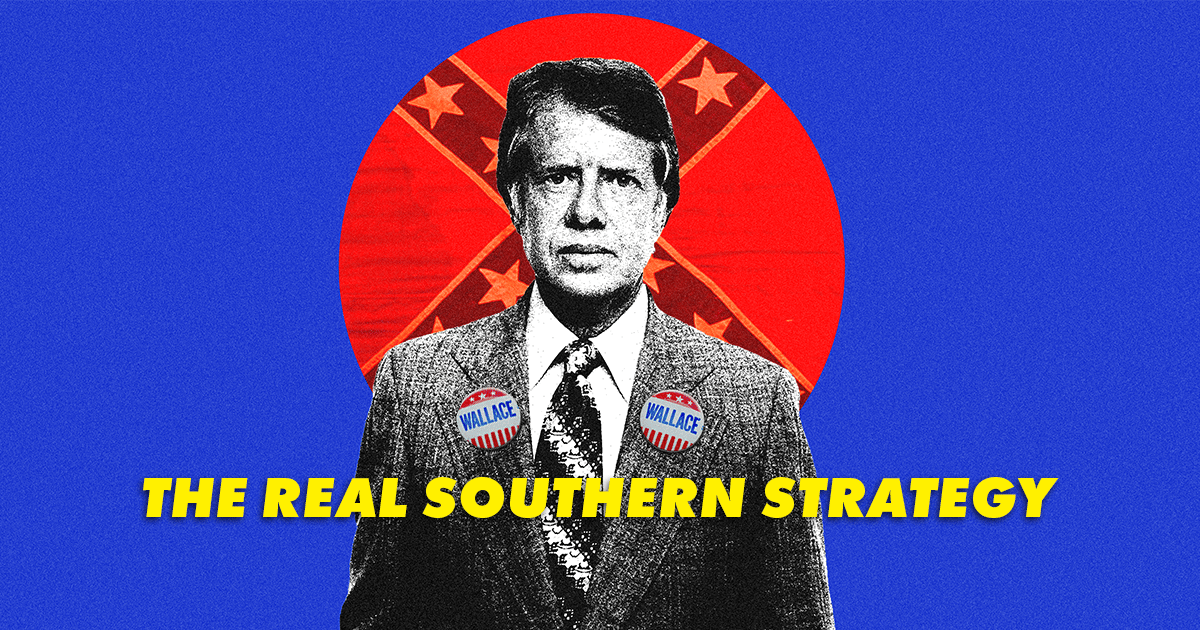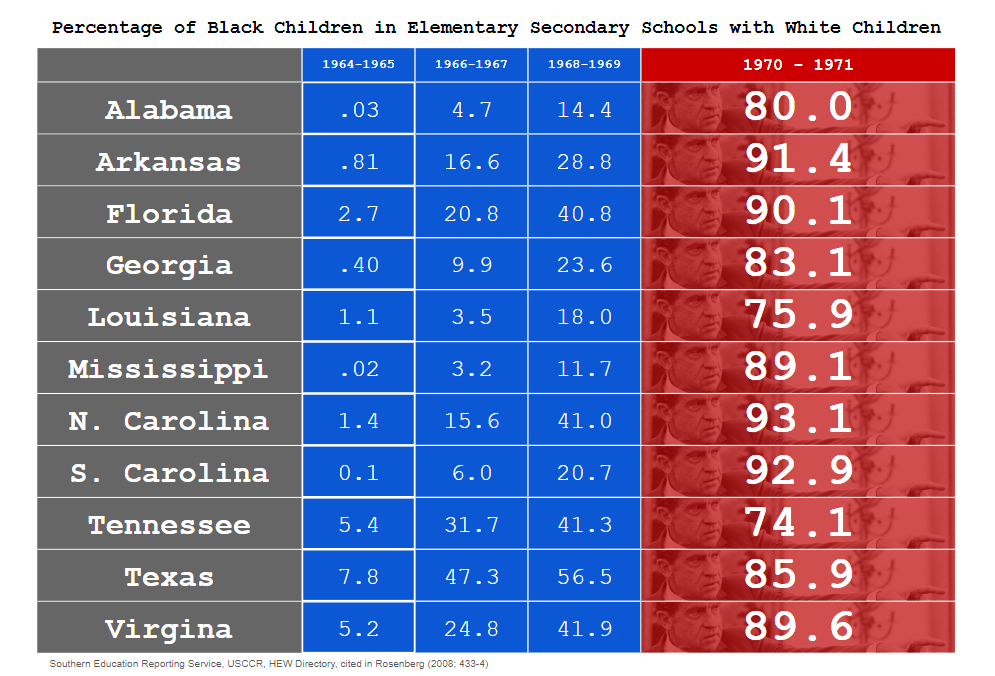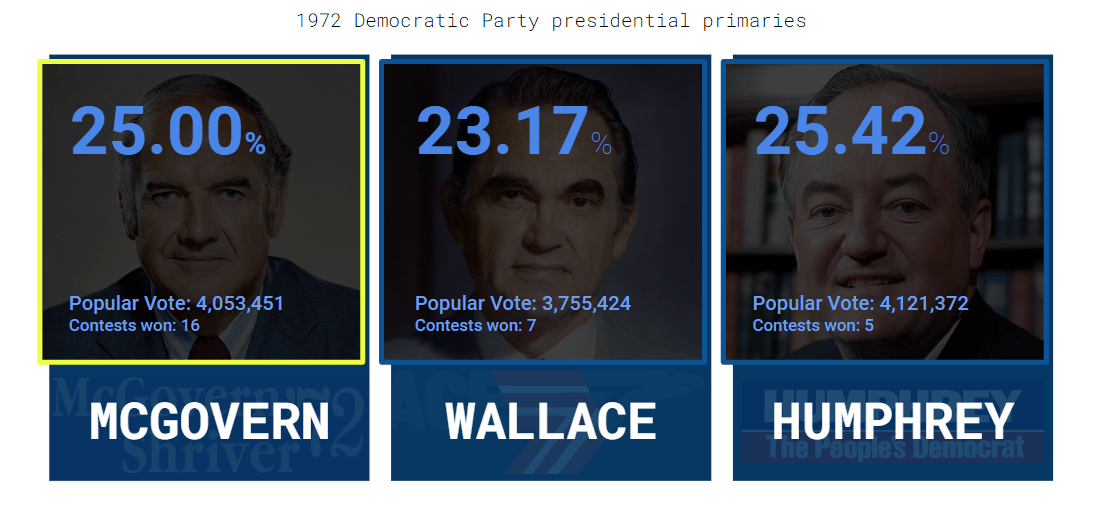
One of the most pervasive explanations of modern politics relies on why the Republican Party came to dominate the American South: the use of racial anti-civil rights politics. This “Southern Strategy,” caused a “Party Switch” of Southern segregationists, which is the foundation of today’s Republican Party. The problem though is that it’s incoherent fiction.
One key to the “Party Switch” narrative happened in the early 1970s. In his best-selling book of essays, historian and Princeton professor Kevin Kruse asserts that “… when it came to [George] Wallace’s and Nixon’s challenges to the civil rights movement, these were differences of degree, not kind.” The claim is that the Republican Party was re-aligning with symbols of segregation like George Wallace on issues like busing while the Democratic Party was abandoning these politics. However, this mythology can only exist by ignoring the man who led the Democratic Party throughout the 1970s, Jimmy Carter.
While Jimmy Carter is remembered simply as a pro-civil rights progressive, his proximity to George Wallace and similarity in politics, were incomparably closer than Wallace was to Nixon. Nixon et al., are erroneously accused of attempting what the leaders of the Democratic Party did.
The reality of Nixon desegregating schools is neither here nor there to a leftist historian, yet Nixon’s completely mainstream and moderate approach to busing is often cited as a prime example of the Republican's sinister “Southern Strategy.” Carter, on the other hand, by 1974 chaired the Campaign Committee for the Democratic Party and of course, led the Democratic ticket in 1976 and 1980, is ignored in discussions about the “Party Switch.” But as you’ll see, Carter had a very real and very shameful Southern Strategy.
As Nixon launched his dastardly plot to safely and constitutionally desegregate schools, the Democratic Southern Strategy took shape.

In September of 1971 at the National Governors Conference, Jimmy Carter and George Wallace both made stands against busing, The Macon News reported:
Gov. Jimmy Carter talks with Gov. George Wallace of Alabama at the opening of the final session of the National Governor’s Conference in San Juan, Puerto Rico Wednesday. Both of them took stands against busing, but their resolutions were defeated at the conference.

AP reported that both Carter and Wallace sponsored similar anti-busing resolutions that both failed.2 Carter’s resolution included asking for a constitutional amendment:
A request to Congress to approve and submit to the states at the earliest possible date an amendment to the constitution to remedy the problems caused by the massive forced busing of school children.3
The Carter and Wallace duo was not just taking a hardline stand against busing to fellow governors, “[Carter] called on public officials and parents to voice a ‘legitimate protest’ over the federally ordered busing.” 4

Their call to action went out to all public officials and parents to oppose busing, and that’s exactly what happened. Carter signed a citizen-led national petition calling for a constitutional amendment to ban busing, with the only notable signees reported at the time were Lester Maddox and George Wallace.5 Concurrently, Nixon was rejecting pleas from George Wallace on busing, while Carter was standing alongside him.6

In November 1971 at the Southern Governors Conference, George Wallace told the Atlanta Press Club that the “New South moderate governors” were largely “just a figment of the press’ imagination.”7 And in classic Southern Democrat fashion, governors agreed to unite on issues and candidates including withholding support from any presidential candidate to strengthen their bargaining hand in national politics. This included passing a Wallace-led anti-busing resolution. One of those governors in favor was Jimmy Carter, who would act on that Southern pledge in 1972.8
Jimmy Carter made good on one of his top gubernatorial campaign promises, inviting George Wallace to speak at the Georgia State House in February 1972. Lt. Gov. Maddox, speaking to the audience of Georgia politicians and media, called Wallace “your voice, my voice and the voice of America.”9

George Wallace is creepy. (10)
Carter gave Wallace a glowing introduction referring to him as a “personal friend of mine who speaks with a loud and clear voice being heard throughout the nation”11 and commending Wallace for leading the Democratic Party on a particular issue:12
[Carter:] I attended a meeting this week… and I heard one of the other presidential candidates, Senator Humphrey, talking to a group of governors… and he was saying in a very frank way what Lt. Gov Maddox has just said: That he had been wrong in failing to recognize legitimate issues raised by George Wallace, that he and many others like him, many running for president this year, had acted in timidity and through subterfuge.
He pointed out specifically the issue of busing… and [Humphrey] said he was ashamed that he had not taken the position earlier that Gov. Wallace had made him take this year.


Carter’s claim was not wholly rejected by Sen. Humphrey, who is regarded as a civil rights champion, and Wallace the symbol of segregation. Wallace gave a speech centered around busing and received “ovations” from those in attendance.13

The Atlanta Constitution, 26 Feb 1972.
In May the attempted assassination of George Wallace left him paralyzed. This ended his 1972 presidential campaign after strong showings in the early Democratic primaries.
Wallace finished third in the tight 1972 Democratic Presidential primary, winning 7 contests and 3.7 million votes (23%); McGovern received 4 million votes (25%); and Humphrey ended with 4.1 million votes (25.42%).14

In June 1972 while George Wallace was recovering from the assassination attempt, his friends, supporters, and colleagues celebrated, “George Wallace Appreciation Day.” Three famous friends of Wallace headlined the rally in Red Level Alabama.15
Alabama Senator, former Vice-Presidential nominee of the Democratic Party, signatory of the Southern Manifesto, and lifelong Democrat, John Sparkman was one of the featured speakers. 16
Another featured speakers was also one of the ugliest champions of racism, white supremacy, and segregation in American history; former Mississippi Governor Ross Barnett. Barnett rose to prominence with some of the most vicious methods of protecting segregation and the one-party rule of Democrats in the state, including inciting the Ole Miss Riots. Another lifelong Democrat and champion of segregation, Barnett told the crowd that day that Wallace was the only man who could beat “tricky Dick Nixon.”17
The third advertised speaker was Jimmy Carter, who delivered a “15 - minute extemporaneous speech full of praise for Wallace.” Carter, who also had Georgia delegate authority in the Democratic National Convention the following week, said “[Wallace] is the most popular figure in our state, including the governor of Georgia.”18


“The only mistake that Gov. Wallace has made this year is to underestimate his popularity all across the United States,” he said in the “soggy evening heat” in the tiny Alabama town. Carter, and his wife, donned campaign buttons of who else but their kind of man, George Wallace.19